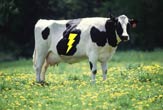Scientists Turn Cow Waste into Electricity

Scientists have generated renewable electricity using natural materials that are cheap and plentiful - cow manure and stomach juices.
Microbes living in the rumen chamber of a cow's stomach break down cellulose - a tough carbohydrate produced by plants, specifically in the grass cows munch on.
This process helps cows digest their meals, but it also releases electrons which scientists can harness for use in a battery. They used about a liter of microbe-rich rumen fluid to produce 600 millivolts of electricity - about half the voltage needed to run one rechargeable AA battery.
"While that's a very small amount of voltage, the results show that it is possible to create electricity from cow waste," said study co-author Ann Christy of Ohio State University.
The rumen is a microbe-laden sac in the cow where food is temporarily stored and churned until it can be completely digested. This fermenting juice is the rumen fluid.
The researchers extracted rumen fluid - chocked full of microbes and cellulose - from a living cow using a tube that lead directly into the cow's rumen. Next they built their fuel cells by pouring the fluid into one of two glass chambers, each about the size of a two-liter soda bottle.
They filled the other chamber with ferricyanide, a chemical that needed to complete the electrical circuit.
Get the world’s most fascinating discoveries delivered straight to your inbox.
The two chambers were separated by a special material that allowed protons to move from the negative chamber into the positive chamber. The movement of protons, as wells as electrons across the resistor wire connecting the chambers, creates electric current.
Output from the microbe-powered fuel cell reached a consistent maximum voltage of about 600 millivolts. After four days, the output fell to 200 millivolts, but researchers bumped it back up to the higher output by simply adding more cellulose.
Christy and her colleagues also built similar fuel cells using cow manure instead of rumen fluid as the energy source. These consistently produced between 300 and 400 millivolts.
"We've run some of these trials well over 30 days without a decrease in the voltage output," Christy said. "Both studies suggest that cow waste is a promising fuel source. It's cheap and plentiful, and it may someday be a useful source of sustainable energy in developing parts of the world."
This isn't the first time scientists have used waste or microbes to generate electricity. One group of scientists found a species of bacteria that eats toxic waste and produces electricity simultaneously. Another group used human urine to generate the same amount of electricity as an AA battery. They hope to use this technique to power small medical kits.
As fossil fuel supplies dwindle and energy prices climb, this new study provides another good starting point for alternative energy sources for the future.
"Although it's too early to tell if this kind of fuel cell can produce significantly more electricity, the fact that the rumen fluid worked in our study means that there are additional electricity-producing microbes that we have yet to identify," Christy said.
Scientists presented this research Aug. 31 at the national meeting of the American Chemical Society in Washington, D.C..
